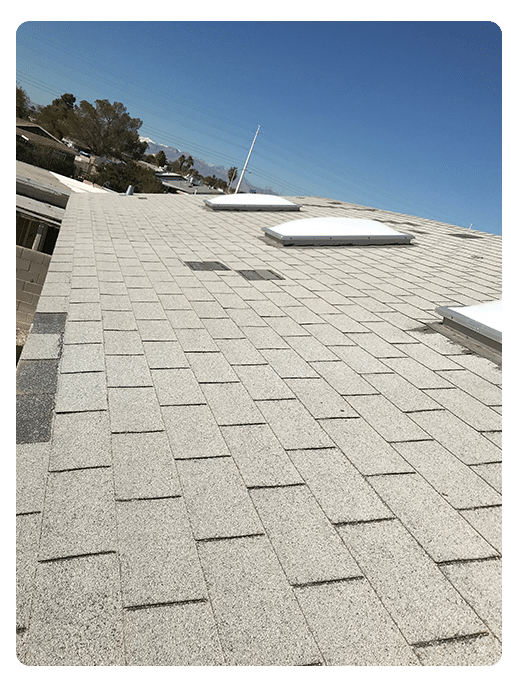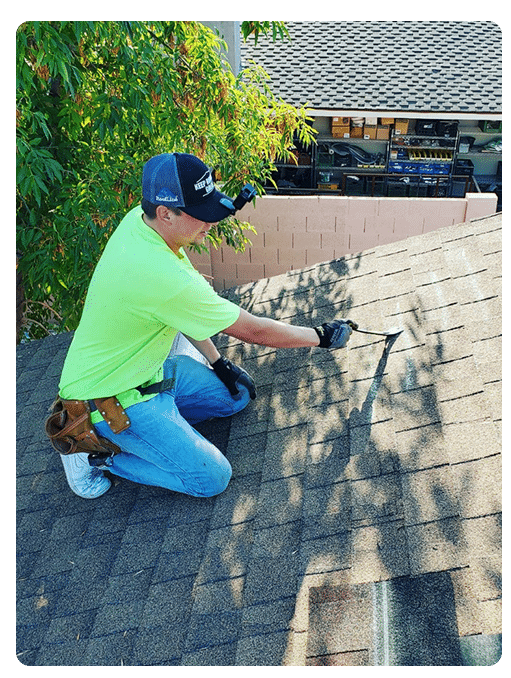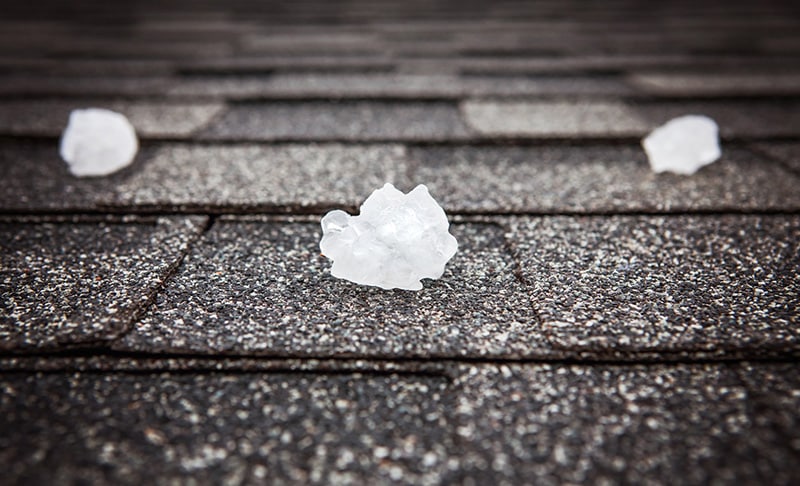Roof shingles are a vital component of any home’s protective layer against the elements. Unfortunately, time and weather can take their toll on even the most resilient roof, leading to damage that needs repair. A prudent homeowner should be familiar with the various cost-effective methods available for repairing damaged roof shingles in order to save money over more expensive replacement options.
The following article will examine the best ways to repair damaged shingles efficiently and effectively without breaking the bank. In particular, this article will explore common causes of damage to roof shingles as well as proper techniques for assessing the extent of damage before attempting repairs. Cost comparisons between do-it-yourself solutions versus professional services also provide insight into which option is right for each individual situation.
With these tips in hand, readers can make an informed decision regarding how best to repair their own damaged shingles with confidence.
Causes Of Roof Shingle Damage
Shingles are an important part of the roof that protect against the elements. Unfortunately, due to their exposure to extreme temperatures and inclement weather conditions, shingles can become damaged over time.
Common types of damage include cracking, blistering, curling, or losing granules from their surface. The main causes of shingle damage are direct sunlight, high winds, ice dams, hail storms and inadequate attic ventilation.
Sunlight is especially damaging because it breaks down the asphalt in shingles faster than normal wear and tear from weather. High winds can cause physical damage by tearing off pieces of shingles or loosening them enough for water to penetrate beneath them.
Ice dams form when melting snow refreezes near the eaves of a house which leads to water seeping up underneath shingles and freezing during cold nights. Hail stones impact roofs with enough force to dent metal and split wood while also leaving marks on asphalt shingles.
Inadequate attic ventilation allows heat to build up in attics which increases the temperature of roofs making them more susceptible to deterioration caused by sun exposure as well as quicker growth of mosses and lichens which further break down asphalt material around nails used for installation.

Repairing damaged shingles is essential for preserving their integrity and keeping out moisture. Thus understanding how these damages occur is key in determining cost-effective ways to repair them.
Assessing The Extent Of Damage
The causes of roof shingle damage are numerous and varied. Rain, wind, hail, sun, snow and ice all contribute to the wear and tear on a roof over time.
It is important to assess the extent of the damage before attempting any repairs in order to ensure that they are effective. A thorough inspection should be conducted by either a qualified professional or someone with extensive experience in roofing systems.
Careful attention should be paid to areas where water has pooled or there is visible staining from leaking. Any damaged flashing around chimneys or skylights should also be inspected. The age of the shingles can also provide an indication as to how much repair will be needed; older roofs may require more intensive work than newer ones.
If possible, it is advisable for two people to inspect the roof together so that any potential issues can be identified quickly and accurately. In terms of cost-effectiveness, repairing existing shingles rather than replacing them altogether is usually recommended if only minor damage has been sustained.
This involves removing loose nails and applying new asphalt-based sealant along cracks or gaps in individual pieces. Completely replacing damaged sections might become necessary in extreme cases, but this option tends to carry higher costs due to labour and materials involved.
No matter what approach is taken, proper maintenance and regular inspections can help reduce future problems with shingle damage.
Replacing Shingles Vs. Repairing
Replacing shingles is a cost-effective way to repair damage. Materials are relatively inexpensive and the process does not require extensive labour costs. The procedure for replacing damaged or missing shingles is straightforward: remove the old shingle, clean off any nails from the area, apply roof cement to seal up any gaps between the new one and its neighbours, then finally affix the replacement in place using four galvanised nails at each corner of the new shingle.
Repairing damaged shingles can also help save money compared with full replacement. Damage such as curling corners or cracked surfaces may be repaired by peeling back an edge of the existing material and applying asphalt patch beneath it before re-securing it. If only small parts of individual tiles have become broken off, they may simply be replaced without fully removing them first.
In either case, once all repairs have been completed, a coat of sealant should be applied over affected areas to ensure no further water ingress occurs in future.
Do-It-Yourself Repair Solutions
Repairing damaged shingles can be a costly endeavor, but there are cost-effective solutions for do-it-yourselfers.
For those who have some experience with roof repair, the first option is to replace individual shingles that have been damaged or missing. This process requires basic tools such as a hammer and nails, along with an appropriate number of new shingles, which may need to be purchased from a local home improvement store. Additionally, it’s important to ensure that all the replacement shingles match in color and design so as not to disrupt the overall appearance of the roof.
Another solution is to use sealants on any cracked or broken areas to prevent further damage. The proper type needed will depend on how severe the damage is and what material has been used for the roof surface; both silicate polymer and asphalt sealant can provide adequate protection if applied properly.
Sealants come in different colors, making them easy to blend into the current surroundings without detracting from curb appeal. To avoid potential problems in cold weather climates, look for products that are specifically designed for winter conditions.
With these simple steps, homeowners can effectively repair their own roofs at minimal cost and maintain its beauty for years to come.
Pros And Cons Of Diy Repairs
Do-it-yourself repair of damaged shingles can be an affordable option, but it is important to consider the potential drawbacks.
One key benefit of DIY repairs is that they provide a cost-saving solution; in many cases, materials required for repairing shingles may only require a small overall investment.
Additionally, taking on the task yourself gives you full control over the process and allows you to customize the job according to your needs and preferences.
However, some aspects of repairing shingles are complex; if not done correctly, mistakes can lead to further damage or even void warranties.
Furthermore, time spent in completing DIY repairs can quickly add up; depending on the extent of damage, it could take several hours or days before a professional finish is achieved.
It is therefore important to weigh these factors carefully when deciding whether to undertake a DIY project.
Professional Repair Services
Professional repair services are often the most cost-effective way to repair damaged shingles. Specialized roofers have the tools and expertise necessary to properly assess a roof’s condition and make any repairs needed, whether they be minor or major.
Professionals can also ensure that all safety protocols are followed while working on a roof, making sure both workers and homeowners alike remain safe during the process.
By deciding to hire an experienced professional for their roofing needs, homeowners will likely save money in the long run due to fewer mistakes being made during installation or repair work.
Professionals may also offer warranties on their workmanship as well as free advice about how best to maintain the longevity of a roof over time.
They can even suggest ways to reduce energy costs by updating insulation materials used within a home’s attic space.
In this way, hiring a professional service provider is more than just saving money; it is investing in one’s future comfort and peace of mind.

Cost Comparison Of Repair Options
When assessing cost-effective ways to repair damaged shingles, it is important to consider the material costs as well as the labor costs.
There are a variety of materials that can be used for roof repairs, including asphalt or fiberglass shingles, metal roof panels and tiles, wood shakes and shingles, slate tiles, and clay or concrete tiles.
Each type of material has its own advantages in terms of durability, longevity, energy efficiency, aesthetic appeal, and ease of installation.
The amount of labor needed will also factor into the overall cost effectiveness of any given repair strategy.
For instance, if the damaged area requires patchwork on existing shingles rather than complete replacement with new ones then this could potentially save time and money.
Similarly, some types of roof materials may require more expertise during installation and thus incur higher labor fees.
Ultimately, comparing all available options from an economic standpoint should help determine which option provides the most bang for your buck in terms of both materials and labor costs.
Conclusion
Repairing damaged shingles is an important part of maintaining a safe and secure roof.
Depending on the extent of damage, there are several options for repairing or replacing shingles that can be tailored to fit any budget.
Do-it-yourself repair solutions offer cost savings but may not provide long lasting results in all cases.
Professional services come at a higher price tag but usually result in longer lasting repairs or replacements.
Careful consideration should be taken when deciding which option will best suit individual needs and requirements.
Ultimately, the most cost effective method of protecting one’s home from further damage caused by worn out shingles is to choose a solution that offers the right balance between quality and affordability.


